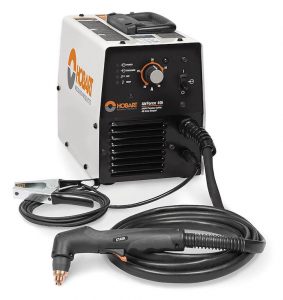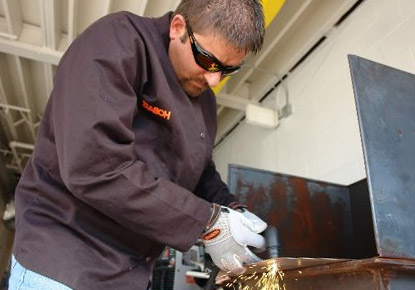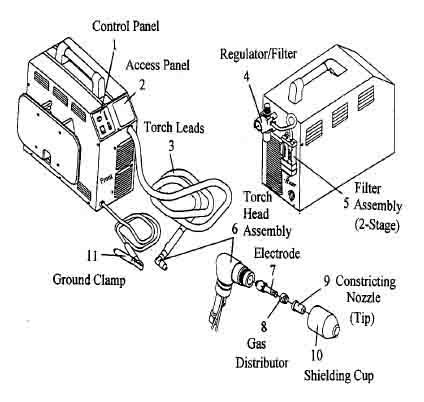
The plasma arc cutting process requires equipment that is within reach from a price and difficulty perspective for hobbyists and welding shops.
Plasma arc equipment includes:
- Torch: small units are air-cooled and larger units are water-cooled
- Electrode tip: copper and tungsten
- Nozzle insulator: between the electrode tip and nozzle tip
- Control unit
- Power supply
- One or more cutting gases
- Supply of clean cooling water
- Regulator assembly containing a pressure regulator to control pounds per square inch of gas used
Equipment is relatively small in size and is available for both manual and mechanized PAC.
RELATED: Best Plasma Cutters – Top Picks & Reviews
Plasma Arc Equipment

Plasma Cutting Torch
A cutting torch consists of an electrode holder which centers the electrode tip with respect to the orifice in the constricting nozzle. The electrode and nozzle are water-cooled to prolong their lives. Plasma gas is injected into the torch around the electrode and exits through the nozzle orifice. Nozzles with various orifice diameters are available for each type of torch. Orifice diameter depends on the cutting current; larger diameters are required at higher currents. Nozzle design depends on the type of PAC and the metal being cut.
Both single and multiple port nozzles may be used for PAC. Multiple port nozzles have auxiliary gas ports arranged in a circle around the main orifice. All of the arc plasma passes through the main orifice with a high gas flew rate per unit area. These nozzles produce better quality cuts than single-port nozzles at equivalent travel speeds. However, cut quality decreases with increasing travel speed. Torch designs for introducing shielding gas or water around the plasma flame are available. PAC torches are similar in appearance to gas tungsten arc welding electrode holders, both manual and machine types. Mechanized PAC torches are mounted on shape cutting machines similar to mechanized oxyfuel gas shape cutting equipment. Cutting may be controlled by photoelectric tracing, numerical control, or computer.

Plasma Arc Equipment Controls
Control consoles for PAC may contain solenoid valves to turn gases and cooling water on and off. They usually have flow-meters for the various types of cutting gases used and a water flow switch to stop the operation if cooling water flow falls below a safe limit. Controls for high-power automatic PAC may also contain programming features for up-slope and downslope of current and orifice gas flow.
Power Sources
Power sources for PAC are specially designed units with open-circuit voltages in the range of 120 to 400 V. A power source is selected on the basis of the design of PAC torch to be used, the type and thickness of the work metal, and the cutting speed range. Their volt-ampere output characteristic must be the typical drooping type.
- Heavy cutting requires high open-circuit voltage (400 V) for the capability of piercing material as thick as 2 in. (51 mm). Low current, manual cutting equipment uses lower open-circuit voltages (120 to 200 V). Some power sources have the connections necessary to change the open-circuit voltage as required for specific applications.
- The output current requirements range from about 70 to 1000 A depending on the material, its thickness, and cutting speed. The unit may also contain the pilot arc and high-frequency power source circuitry.
Gas Selection
Cutting gas selection depends on the material being cut and the cut surface quality requirements. Most nonferrous metals are cut by using nitrogen, nitrogen-hydrogen mixtures, or argon-hydrogen mixtures. Titanium and zirconium are cut with pure argon because of their susceptibility to embrittlement by reactive gases.
(Carbon steels are cut by using compressed air (80 percent N2, 20 percent 02) or nitrogen for plasma gas. Nitrogen is used with the water injection method of PAC. Some systems use nitrogen for the plasma forming gas with oxygen injected into the plasma downstream of the electrode. This arrangement prolongs the life of the electrode by not exposing it to oxygen.
For some nonferrous cutting with the dual flow system, nitrogen is used for the plasma gas with carbon dioxide (C02) for shielding. For better quality cuts, argon-hydrogen plasma gas and nitrogen shielding are used.